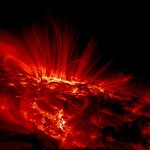Sunspots to disappear, but Earth will continue to warm up
Sunspots are supposed to be at their peak activity around next year according to scientists who calculates solar cycles that have been tracked centuries ago.
But lately, scientists are baffled by the surprise realization that their calculations may be so off that instead of a burst of solar activity, sunspots will essentially disappear and remain that way for several years.
The opposing trend was shown by three recent studies in the U.S. which shows that the often-reliable sunspot cycle may be shutting down in a phase not seen since the 17th century.
"This is highly unusual and unexpected," said Frank Hill, who is the associate director of the Solar Synoptic Network of the National Solar Observatory and Air Force Research Laboratory.
Hill, speaking at the annual conference of the American Astronomical Society's Solar Physics Division in Las Cruces, New Mexico, said, "But the fact that three completely different views of the Sun point in the same direction is a powerful indicator that the sunspot cycle may be going into hibernation."
Sunspots had been monitored to peak every 11 years but the current cycle is now expected to be the last "normal" one according to scientists.
They are monitoring sunspots and other solar phenomena because they have a direct impact on everyday life on Earth by interfering and damaging communications, GPS systems and airline flight controls.
Scientists are trying to determine if the upcoming inactivity of sunspots may be headed to a similar period like that from 1645 to 1715 when sunspots were absent and a "Little Ice Age" ensued. But climatologists say the persistent effects of global warming will overshadow the mild temperature-lowering effect of the disappearance of sunspots.
